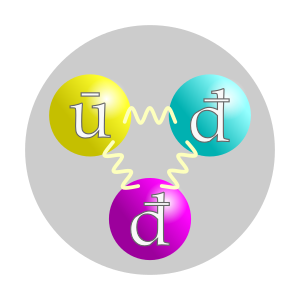Antineutron facts for kids
An antineutron is like a "mirror image" or opposite version of a regular neutron. Scientists discovered antineutrons in 1956 at the University of California, Berkeley.
Antineutrons are very similar to neutrons in many ways. They have the exact same mass, which means they weigh the same. They also have no electric charge, just like neutrons. This means they are neutral.
Contents
What Makes an Antineutron Special?
Even though antineutrons are very similar to neutrons, there's one key difference. All matter, including neutrons, is made of tiny particles called quarks. Antineutrons are made of anti-quarks. Anti-quarks are the opposite of quarks.
Baryon Number: The Key Difference
Scientists use something called a "baryon number" to describe particles like neutrons and antineutrons.
- A neutron has a baryon number of +1.
- An antineutron has a baryon number of -1.
This opposite baryon number is how we know they are antiparticles of each other.
What Happens When an Antineutron Meets a Neutron?
When an antineutron touches a regular neutron, they both disappear in a burst of energy. This process is called annihilation. It's like they cancel each other out, turning their mass into pure energy. This is a powerful reaction that releases a lot of energy.
See also
 In Spanish: Antineutrón para niños
In Spanish: Antineutrón para niños


